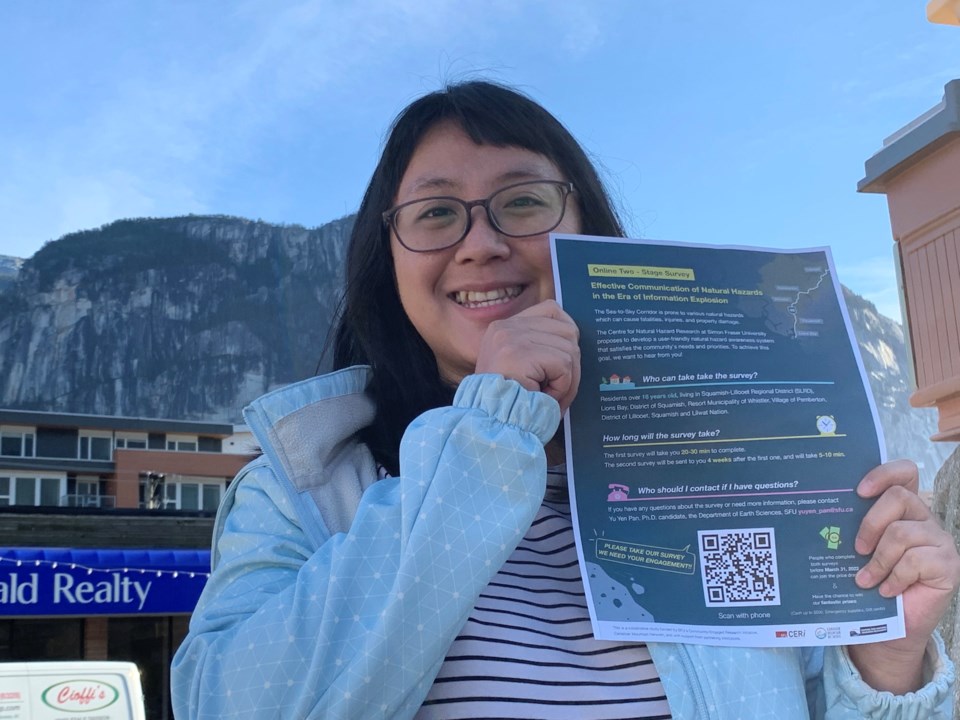Taking this 20-minute survey will make you wonder why you haven't yet packed an emergency grab-and-go bag.
The Sea to Sky Corridor questionnaire from Simon Fraser University (SFU) aims to develop an effective natural hazard communication system for the corridor.
It asks how aware you are of local hazards — newsflash, we have a lot — what you have done to prepare to evacuate if you understand the differences between evacuation alerts and orders, and how you seek information when natural disasters occur.
While the results are what researchers are after, the survey itself is educational and insightful for participants — it requires reflection on what you know about local hazards, what you have done and how you consume news.
The 'Effective communication of Natural Hazard in the era of information explosion' survey expands on one done in 2020 by Veronica Woodruff, also from the Centre for Natural Hazard Research (CNHR) at SFU.
This iteration will further help inform local governments and scientists about the best way to reach locals in case of emergency and help fill in the gaps between what agencies think they know and the reality on the ground regarding natural hazard preparedness in our community.
With the plethora of ways folks are bombarded with information these days, breaking through the noise is essential when the worst happens and lives are on the line, said YuYen Pan, a PhD student from SFU's Department of Earth Sciences/CNHR.
"They just scroll, scroll, scroll, so how do we make them stop to read it?" she said.
Residents over 18 years old in the following communities are encouraged to fill out the survey: Lions Bay, Squamish-Lillooet Regional District, Squamish, Whistler, Pemberton, Lillooet, Squamish Nation, and Lil'wat Nation.
The Sea to Sky was chosen not just for the number of hazards in our area — the corridor has the potential for more hazards than most places in the province, including earthquakes, wildfires, floods and severe weather — but because of its different types of communities, Pan said.
“The corridor is composed of abundant scattered, rural communities and a few bigger municipalities,” she said.
“Also, population growth, the shift of industry — hunting, forestry, fishing has gradually shifted to tourism in SLRD A and B — in recent years may also change how people respond to natural hazard emergencies,” Pan said.
“Because of these dynamics, I think the Sea to Sky is a great place to observe the differences between communities.”
A second survey will be sent out to participants about four weeks after the first. This second survey is much shorter, taking between five and 10 minutes to complete.
Results from the surveys will help researchers better understand: locals' preparedness for and perception of natural hazards; factors that influence community response, such as trust, finances and perception of responsibility; and the effectiveness of different modes for information.
"We have found that [people's] awareness and preparedness have some missing links," said Pan.
"For example, some people would say, 'Yes, I know I live in a flood area. Yes, I know I am close to a [potential] landslide, but I don't have a grab-and-go bag.' Why don't you have it? It is interesting to know."
The assumption is that the more aware people are about hazards, the more likely they are to be prepared, but that is not always the case, Pan said.
Figuring out why people don't take action, their level of understanding, and how they are most impacted by emergency news — do they turn to the radio, newspaper or social media, for example — can help leaders reach more people when emergency strikes.
Results of the CNHR surveys will be released after responses have all been compiled, Pan said.
To make it representative, at least 400 locals need to participate. Thus, researchers are offering prizes for participants who complete the first survey by March 31.
Participants have a chance to win one of six cash prizes of $500, gift cards, and emergency preparedness supplies.
After the data from the surveys has been analyzed, the plan is to have local workshops with scientists regarding natural hazards.
Click here to take the first survey.
For more information about the surveys, go to the CNHR website, to the Facebook page or to @CNHR_SFU on Twitter.




